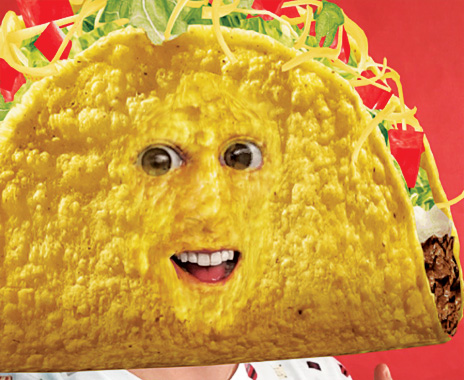Young consumers have lots of distractions these days. Attention spans are getting shorter and shorter, giving brands less time than ever to make an impression.
Perhaps that’s why Snapchat—best known for fleeting photos and videos that catch a pop-culture moment, then disappear—has emerged as the social media mirror to a generation’s soul.
Taco Bell totally gets that. Consider that Taco Bell’s image is edgy, but smirky. And its key customers—Millennials and Gen Z—spend more time playing on mobile phones than their parents do working on computers. That gave Taco Bell’s social media marketing team an idea: What if millions of the brand’s best customers could turn themselves into visual tacos via Snapchat, then share that entirely goofy but branded image with their friends?
The idea became a social media tsunami. The company shattered a Snapchat record on May 5—Cinco de Mayo—when it launched a sponsored lens campaign on Snapchat that appeared to turn customer heads into giant taco shells. The Snapchat filter amassed a record 224 million views in one day.
There’s more. While the typical person spends about 8 seconds looking at a Snapchat image, the average play time of the “Taco Head” image was three times that, at 24 seconds.
“Those numbers were beyond exciting for us,” says Ryan Rimsnider, senior manager of social strategy at Taco Bell.
Is it any wonder why Snapchat has emerged as marketers’ dream tool to reach pre-teens, teens, and 20-somethings?
“Snapchat caters to our photo-obsessed youth while infusing another key aspect of young culture today: transience,” writes Lindsey Weintraub, social media strategist with Immersive Youth Marketing, in a blog post for the firm. “Snapchat makes it socially acceptable for you to publicly share secrets. It’s the ultimate inside-joke machine.”
For capturing and engaging young consumers, Snapchat arguably leaves Instagram and Twitter in the social media dust. Nearly one in five Americans—56.8 million people—will use Snapchat this year, according to eMarketer. By 2020, Snapchat will add 26.9 million users, about double the gain of Twitter and Pinterest, says eMarketer. What’s more, a Nielsen study commissioned by Snapchat revealed that the social media platform reaches an astronomical 41 percent of all U.S. 18–34-year-olds.
“In a world in which there is an app for nearly everything, Snapchat has cut through the clutter by injecting fun back into social sharing,” says Cathy Boyle, principal analyst at eMarketer.
The fast-food world is starting to understand that. Some of the biggest quick-service chains, including McDonald’s and Starbucks, introduced Snapchat filters in recent months. Many smaller chains are catching on, too.
Three years ago, Taco Bell sent its first “snap” to announce that its Beefy Crunch Burrito was coming back. Fast-forward to earlier this year and Taco Bell executives approached Snapchat about how to turn consumer heads into giant tacos via a so-called Snapchat Lens. Here’s how it works: A facial recognition scanner focuses on the consumer’s eyes and mouth and places the taco image there. The lower-left corner of the image even has the branded logo “Live Mas,” and the familiar Taco Bell chimes are integrated into the experience.
Taco Bell execs were blown away by the consumer response, which is the most-viewed Snapchat Lens to date. “With Snapchat, there’s no formality,” Rimsnider says. “You move in and you move out and get on with your lives.” Unlike stuff typically posted on Instagram or Twitter, he adds, “it’s not meant to be polished or highly curated” because the image disappears in 10 seconds.
Lemonade, a 23-unit, cafeteria-style fast casual 2.0 chain based in Los Angeles that serves comfort food with Millennial flair, is also betting big on Snapchat. The brand likes Snapchat because, unlike Instagram or Twitter, it’s entirely mobile-based, says Matt Smith, director of partnerships for Simmer Media Group, which consults Lemonade on its social media marketing. “The other cool thing is the content takes up the entire screen,” he adds.
Lemonade has uploaded Snapchat sequential videos of some of its store openings. What guests like to see most are behind-the-scenes videos that show workers prepping the food, says Kate Berry, marketing manger for Lemonade. At a recent store opening in Yorba Linda, California, the chain used a Snapchat geo filter so consumers could “stamp” Lemonade’s branding on their posts.
“The most important thing for us is allowing customers to feel like they’re one with the brand,” Berry says. Using Snapchat accomplishes just that, she says, “by making it authentic.”
But Snapchat isn’t for everyone, Taco Bell’s Rimsnider says, adding that it can take plenty of time to grow and develop an audience via Snapchat. In addition, unlike Facebook and Twitter, Snapchat is far more hesitant to share metrics with advertisers.
Smith says Snapchat is the single best way to capture the 13–34-year-old demographic. Any restaurant brand hoping to reach that segment, he says, “will eventually have to get with Snapchat and figure out ways to regularly upload content.”







